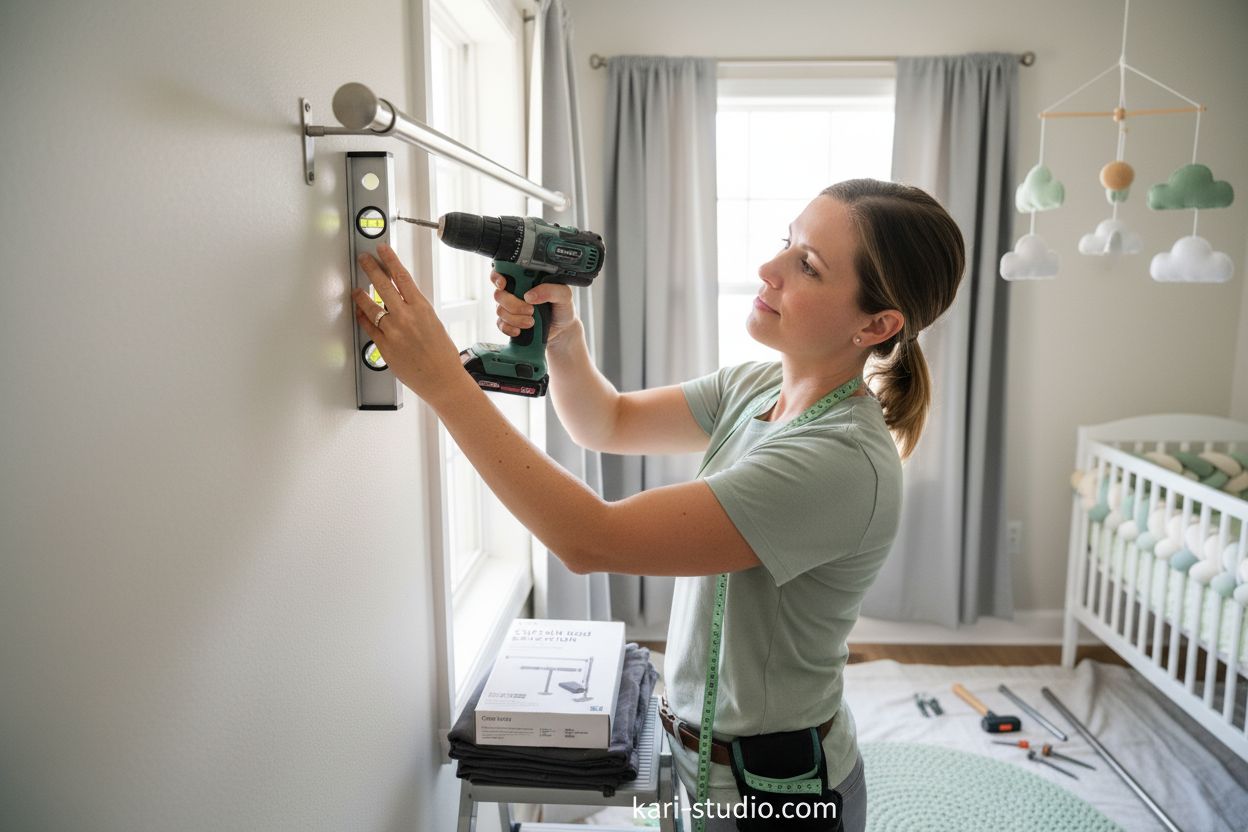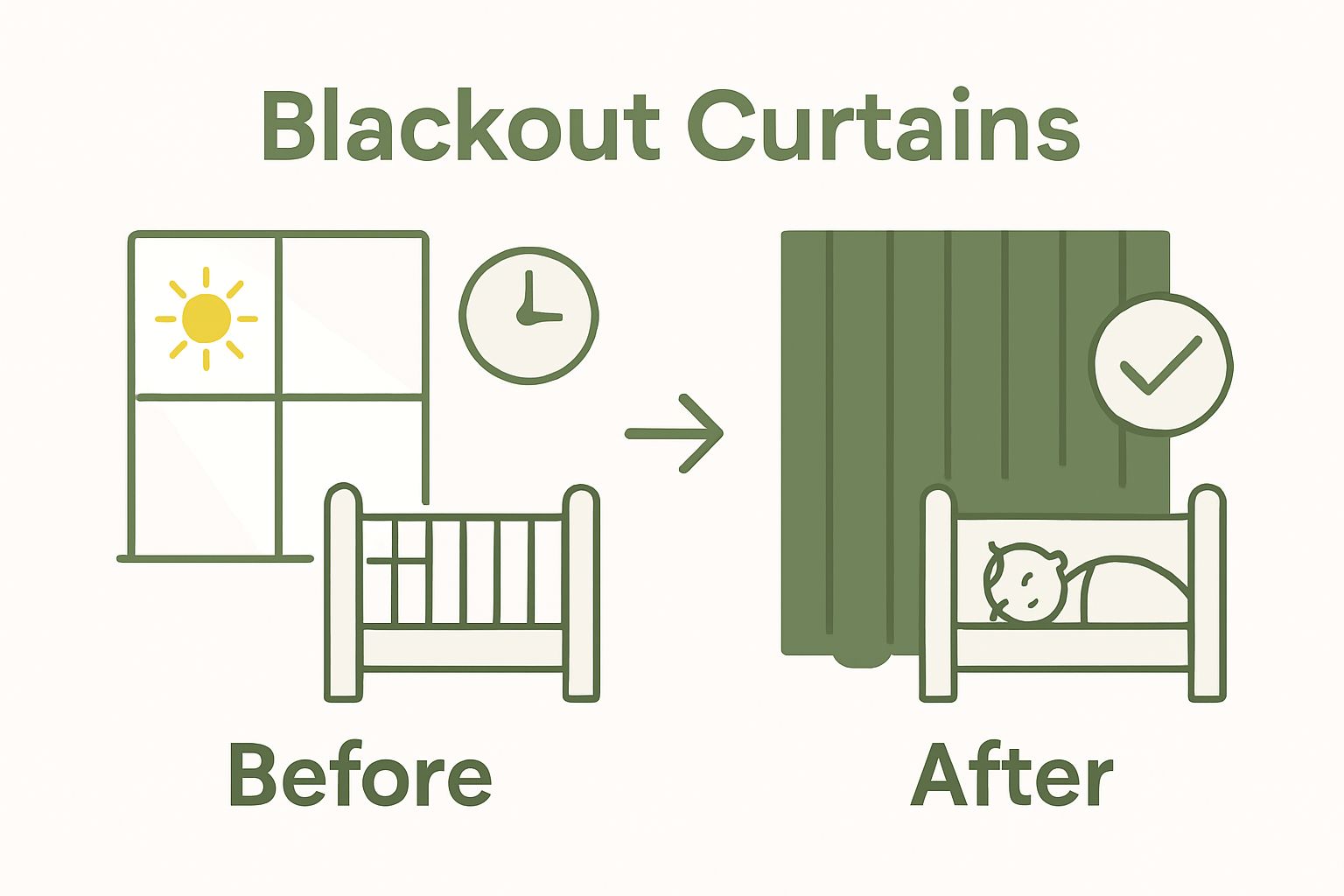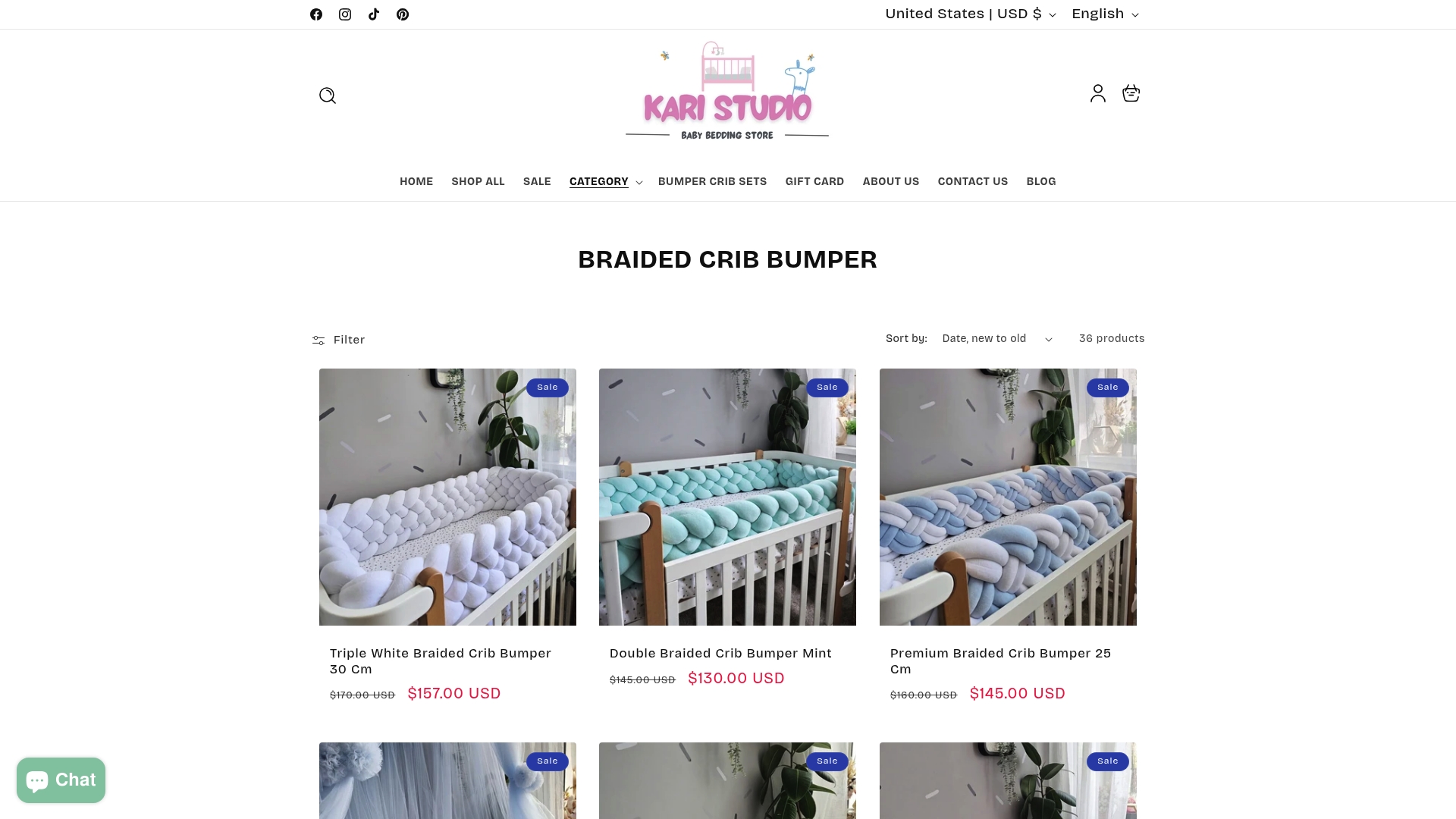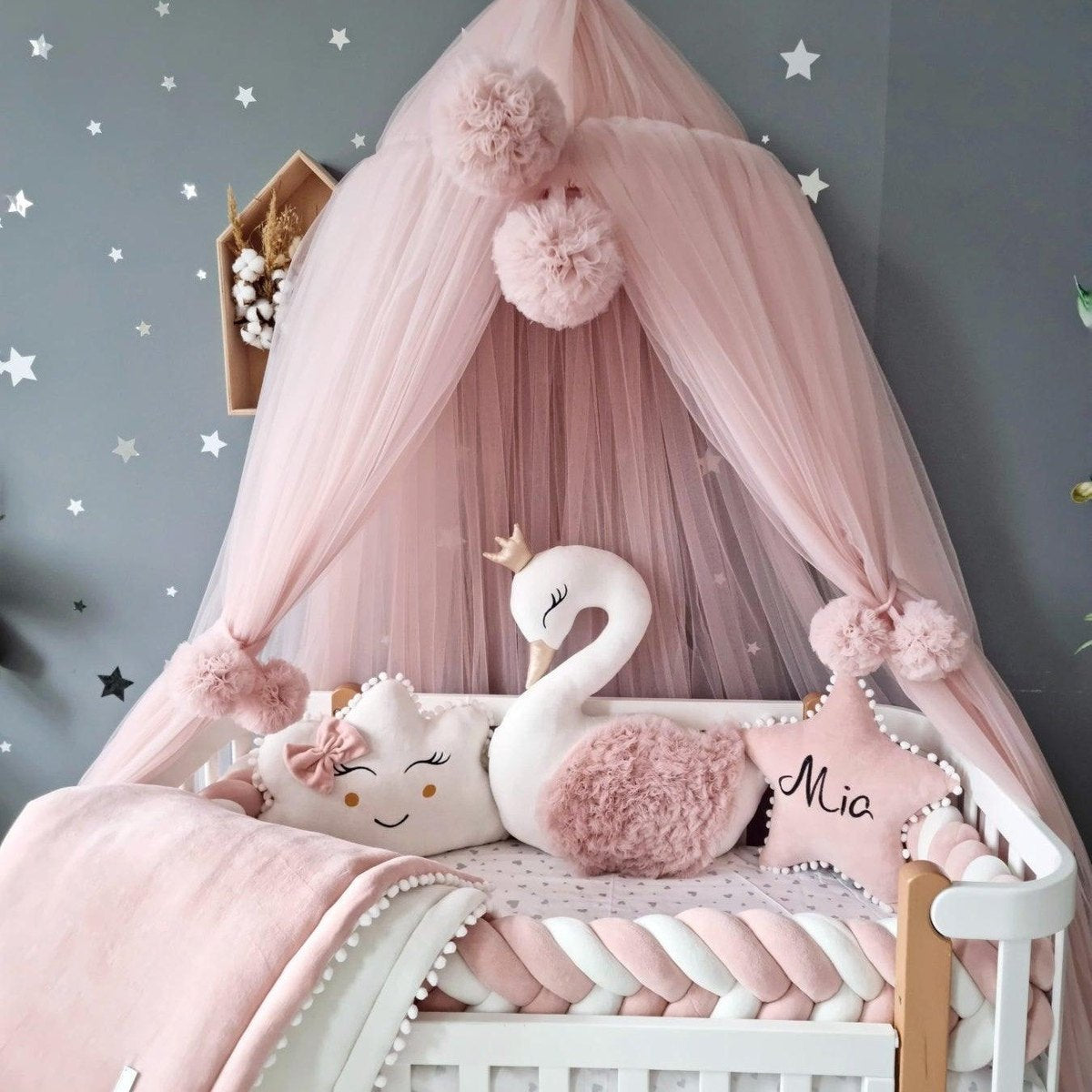Eltern fragen sich oft, wie sie ihrem Baby erholsame Nächte und lange Nickerchen ermöglichen können. Studien zeigen jedoch, dass natürliches Licht den Schlafrhythmus von Babys stärker beeinflusst als fast jeder andere Faktor im Kinderzimmer . Die meisten hängen einfach dicke Vorhänge auf und hoffen das Beste. Überraschenderweise können ein paar sorgfältige Schritte bei der Auswahl und Anbringung von Verdunkelungsvorhängen den Schlaf Ihres Babys völlig verändern – und unruhige Nächte gehören der Vergangenheit an.
Inhaltsverzeichnis
- Schritt 1: Bewerten Sie die Lichtverhältnisse in Ihrem Kinderzimmer
- Schritt 2: Bestimmen Sie Ihre Stoff- und Stilvorlieben
- Schritt 3: Messen Sie Ihre Fenstermaße genau
- Schritt 4: Wählen Sie die richtige Gardinenstange und das richtige Aufhängesystem
- Schritt 5: Installieren und testen Sie die Vorhänge auf Wirksamkeit
Kurze Zusammenfassung
| Kernpunkt | Erläuterung |
|---|---|
| 1. Bewerten Sie die Lichtverhältnisse im Kinderzimmer gründlich | Informieren Sie sich über den Einfluss des natürlichen Lichts auf das Kinderzimmer, um die Auswahl der Vorhänge zu erleichtern und die Schlafqualität Ihres Babys zu verbessern. |
| 2. Wählen Sie schwere, dichte Stoffe für Vorhänge | Verwenden Sie schwere Materialien, um eine effektive Lichtblockierung und Temperaturregulierung für eine angenehme Umgebung zu gewährleisten. |
| 3. Fenster genau ausmessen | Präzise Fenstermaße verhindern Lichtlücken und sorgen dafür, dass die Vorhänge bequem sitzen und optimal funktionieren. |
| 4. Wählen Sie stabile Gardinenstangen und Halterungen | Robuste Beschläge halten schwere Verdunkelungsvorhänge und verbessern die allgemeine Wirksamkeit beim Blockieren von Licht. |
| 5. Testen und überwachen Sie die Ergebnisse der Vorhanginstallation | Beobachten Sie nach der Installation die Schlafmuster Ihres Babys, um die Wirksamkeit Ihrer Verdunkelungsvorhänge zu beurteilen. |
Schritt 1: Bewerten Sie die Lichtverhältnisse in Ihrem Kinderzimmer
Die Wahl von Verdunkelungsvorhängen fürs Kinderzimmer beginnt mit einer genauen Analyse der Lichtverhältnisse in Ihrem Zimmer. Bevor Sie sich für eine Fensterdekoration entscheiden, sollten Sie eine gründliche Lichtanalyse durchführen, die Ihre Strategie zur Vorhangauswahl beeinflusst.
Untersuchen Sie zunächst die Fensterausrichtung Ihres Kinderzimmers und die natürlichen Lichtverhältnisse im Tagesverlauf. Süd- und Westfenster erhalten in der Regel intensiveres Sonnenlicht, was zu einer höheren Wahrscheinlichkeit von Hitze- und Helligkeitsstörungen während des Mittagsschlafs und des Nachtschlafs führt. Gehen Sie zu verschiedenen Tageszeiten im Zimmer umher und beobachten Sie, wie das Sonnenlicht in den Raum einfällt. Natürliches Licht kann die Schlafqualität eines Säuglings erheblich beeinflussen , daher ist es wichtig, diese Muster zu verstehen.
Messen Sie Ihre Fenster genau aus. Achten Sie dabei nicht nur auf Breite und Höhe, sondern auch auf die Tiefe der Fensterrahmen und mögliche Hindernisse wie Heizkörper, Möbel oder architektonische Elemente, die die Montage der Vorhänge beeinträchtigen könnten. Genaue Messungen vermeiden späteren Frust und sorgen für eine perfekte Passform. Verwenden Sie ein Metallmaßband für Präzision und notieren Sie die Maße sowohl in Zoll als auch in Zentimetern, um beim Einkauf flexibel zu sein.
Berücksichtigen Sie zusätzliche Lichtquellen im Zimmer neben den Fenstern. Deckenleuchten, Nachtlichter, Flurbeleuchtung und elektronische Geräte können die Umgebungshelligkeit erhöhen und den Schlaf Ihres Babys stören. Lesen Sie unseren Leitfaden zur optimalen Beleuchtung im Kinderzimmer, um zu verstehen, wie verschiedene Lichtquellen interagieren und den Schlafrhythmus Ihres Babys beeinflussen.
Fotografieren Sie die Fenster Ihres Kinderzimmers morgens, nachmittags und abends, um eine umfassende Lichtkarte zu erstellen. Diese visuellen Referenzen helfen Ihnen, Ihre spezifischen Bedürfnisse bei der Auswahl von Verdunkelungsvorhängen zu kommunizieren und liefern eine klare Darstellung der individuellen Lichtverhältnisse Ihres Zimmers. Achten Sie besonders auf den Lichteinfall während der Hauptschlafzeiten von Kleinkindern, typischerweise zwischen 10 und 14 Uhr und nach 19 Uhr.
Durch eine sorgfältige Beurteilung der Lichtverhältnisse in Ihrem Kinderzimmer schaffen Sie eine strategische Grundlage für die Auswahl von Verdunkelungsvorhängen, die die Schlafumgebung Ihres Babys optimieren. Je präziser Ihre anfängliche Beurteilung, desto gezielter und effektiver wird Ihre Vorhangauswahl sein.
Schritt 2: Bestimmen Sie Ihre Stoff- und Stilvorlieben
Die Wahl des richtigen Stoffes und Stils für Verdunkelungsvorhänge im Kinderzimmer erfordert mehr als nur ästhetische Überlegungen. Ihre Wahl wirkt sich direkt auf die Lichtschutzwirkung, die Raumtemperaturregulierung und den allgemeinen Komfort für Ihr Baby aus. Machen Sie sich zunächst mit den einzigartigen Eigenschaften verschiedener Vorhangmaterialien vertraut und erfahren Sie, wie sie zu einer idealen Schlafumgebung beitragen.
Stoffgewicht und -dichte sind entscheidende Faktoren für die Lichtblockierung. Schwere Stoffe wie dicker Polyester, Samt und speziell entwickelte Verdunkelungsstoffe bieten eine bessere Lichtunterdrückung als leichtere Textilien. Achten Sie auf Vorhänge mit mehreren Stofflagen oder integriertem Verdunkelungsfutter, die maximale Dunkelheit garantieren. Synthetische Materialien bieten oft eine bessere Lichtblockierung und sind in der Regel günstiger und pflegeleichter als Alternativen aus Naturfasern.
Berücksichtigen Sie bei der Auswahl der Gardinen die Ästhetik des Raumes. Moderne Kinderzimmer profitieren von klaren, minimalistischen Gardinendesigns in neutralen Farben, die eine ruhige Atmosphäre schaffen. Traditionelle Räume können hingegen kunstvollere Gardinen mit dezenten Mustern oder strukturierten Stoffen integrieren. Entdecken Sie unsere kuratierte Sammlung von Ideen für die Kinderzimmerdekoration und erfahren Sie, wie Gardinen zu einem breiteren Designthema passen.
Die Textur spielt nicht nur eine optische, sondern auch eine wichtige Rolle. Weiche, glatte Stoffe schaffen ein beruhigendes Gefühl und reduzieren mögliche Hautirritationen bei empfindlicher Babyhaut. Mikrofaser- und Polyestermischungen bieten eine hervorragende Kombination aus Weichheit, Strapazierfähigkeit und Lichtschutz. Vermeiden Sie raue oder kratzige Materialien, die Unbehagen oder eine Reizüberflutung verursachen können.
Praktische Überlegungen sollten Sie bei der Auswahl berücksichtigen. Maschinenwaschbare Stoffe mit knitterfreien Eigenschaften sparen vielbeschäftigten Eltern Zeit und Energie. Dunkle oder mittlere Farbtöne blockieren Licht in der Regel besser als helle, blasse Farben. Denken Sie außerdem an Vorhänge mit wärmeisolierenden Eigenschaften, die für eine konstante Raumtemperatur sorgen und zu einem erholsameren Schlafklima beitragen.
Überprüfen Sie Ihre Stoff- und Stilauswahl, indem Sie Stoffmuster an die Wände Ihres Kinderzimmers halten, die Lichtschutzeigenschaften prüfen und beurteilen, wie sie mit der vorhandenen Raumdekoration harmonieren. Ihr Ziel ist es, Verdunkelungsvorhänge zu finden, die nicht nur perfekt funktionieren, sondern auch einen ruhigen, gemütlichen Raum schaffen, in dem Ihr Baby friedlich schlafen kann.
Schritt 3: Messen Sie Ihre Fenstermaße genau
Präzise Fenstermaße sind die Grundlage für die Auswahl perfekter Verdunkelungsvorhänge fürs Kinderzimmer. Schon eine einzige Fehlkalkulation kann die Lichtschutzwirkung und die Gesamtästhetik des Raumes beeinträchtigen. Legen Sie sich zunächst die wichtigsten Werkzeuge zurecht: ein Metallmaßband, einen Bleistift und einen Notizblock, um Ihre Ergebnisse präzise zu dokumentieren.
Breitenmessungen erfordern sorgfältige Sorgfalt . Messen Sie den Fensterrahmen von Innenkante zu Innenkante an drei verschiedenen Punkten: oben, in der Mitte und unten. Diese Maße können aufgrund älterer Bauweise oder möglicher Wandunebenheiten leicht variieren. Notieren Sie das kleinste Maß, um sicherzustellen, dass die Vorhänge bequem passen, ohne den Stoff zu spannen oder zu strecken. Rechnen Sie beim Kauf von Vorhängen zusätzlich 10 bis 15 cm zu Ihrem Breitenmaß hinzu, um eine optimale Lichtabschirmung zu gewährleisten und einen ordnungsgemäßen Fall des Stoffes zu ermöglichen.
Auch die Höhenmessung erfordert Präzision. Entscheiden Sie, ob Sie bodenlange Vorhänge oder einen maßgeschneiderten Look wünschen, der knapp unter der Fensterbank endet. Für einen umfassenden Lichtschutz empfehlen Experten, die Gardinenmaße mehrere Zentimeter über den Fensterrahmen hinaus zu verlängern . Messen Sie von der Gardinenstangenposition bis zum gewünschten Endpunkt und berücksichtigen Sie dabei die Stangenhöhe und die Bodenfreiheit.
Berücksichtigen Sie beim Bemessen Ihrer Gardinenstange unbedingt die Montageart. Für die Innenmontage sind exakte Fensterrahmenmaße erforderlich, während die Außenmontage mehr Flexibilität bietet. Die Platzierung der Stange beeinflusst die Lichtabschirmung erheblich . Wenn Sie die Gardinenstangen 7,5 bis 10 cm über dem Fensterrahmen anbringen und diese auf jeder Seite 5 bis 7,5 cm überragen, entsteht ein lichtundurchlässiger Bereich, der unerwünschtes Licht minimiert.
Spezielle Fensterkonfigurationen wie Erkerfenster, Bogenfenster oder unregelmäßig geformte Öffnungen erfordern zusätzliche, strategische Messtechniken. Erstellen Sie in diesen Fällen eine detaillierte Skizze Ihres Fensters und notieren Sie die genauen Maße und alle besonderen architektonischen Elemente. Diese visuelle Referenz ist ein unschätzbares Hilfsmittel bei der Beratung durch Vorhangspezialisten oder beim Online-Kauf.
Überprüfen Sie Ihre Messungen, indem Sie jede Zahl doppelt prüfen und Ihre Notizen vergleichen. Ein systematisches Vorgehen verhindert kostspielige Fehler und stellt sicher, dass Ihre Verdunkelungsvorhänge genau wie vorgesehen funktionieren. Denken Sie daran: Genaue Messungen sind Ihre erste Verteidigungslinie, um eine perfekt dunkle, ruhige Schlafumgebung für Ihr Baby zu schaffen.
Schritt 4: Wählen Sie die richtige Gardinenstange und das richtige Aufhängesystem
Die Wahl der passenden Gardinenstange und des passenden Aufhängesystems ist entscheidend für eine optimale Lichtabschirmung und eine stabile Fensterlösung für Ihr Kinderzimmer. Die richtige Hardware kann die Wirksamkeit Ihrer Verdunkelungsvorhänge entscheidend beeinflussen und eine einfache Fensterabdeckung in ein umfassendes Lichtmanagementsystem verwandeln.
Bei der Wahl der Gardinenstangen ist die Materialauswahl entscheidend. Entscheiden Sie sich für robuste Metalle wie Aluminium oder Stahl, die stabilen Halt bieten, ohne optisch unnötig aufzutragen. Verstellbare Stangen bieten Flexibilität für unterschiedliche Fenstergrößen und ermöglichen eine präzise Positionierung, um Lichtlücken zu minimieren. Achten Sie auf den Stangendurchmesser. Aluminiumstangen zwischen 2,5 und 3,8 cm bieten optimalen Halt für schwerere Verdunkelungsvorhänge, ohne im Kinderzimmer zu industriell zu wirken.
Die Montagemöglichkeiten bieten vielfältige strategische Ansätze zur Lichtunterdrückung. Tageslichtsteuerungssysteme empfehlen umlaufende oder deckenmontierte Stangen, die umfassende Lichtbarrieren schaffen. Deckenmontierte Schienen schließen seitliche Lücken vollständig aus und bieten im Vergleich zu herkömmlichen Wandstangen eine bessere Lichtblockierung. Mit diesen Systemen können Vorhänge bündig an der Wand anliegen und verhindern, dass Licht durch die Ränder dringt.
Die Auswahl der Halterungen erfordert sorgfältige Überlegung . Wählen Sie Halterungen mit ausreichendem Abstand zur Wand, damit die Vorhänge ohne Berührung der Fensterrahmen hängen können. Für Kinderzimmer mit tiefen Fensternischen bieten ausziehbare Halterungen individuelle Lösungen, die die korrekte Positionierung der Vorhänge gewährleisten. Wählen Sie Halterungen aus rostbeständigen Materialien, die das Gewicht schwerer Verdunkelungsstoffe tragen können, ohne sich zu verziehen oder zu verbiegen.
Die Gewichtskapazität stellt einen weiteren entscheidenden Faktor bei der Auswahl von Stangen und Aufhängesystemen dar. Verdunkelungsvorhänge wiegen in der Regel mehr als herkömmliche Fensterdekorationen und erfordern daher Beschläge, die für erhebliche Belastungen ausgelegt sind.
 Überprüfen Sie die Gewichtsangaben des Herstellers und wählen Sie Systeme, die mindestens das 1,5-fache des tatsächlichen Vorhanggewichts tragen. Diese zusätzliche Tragkraft gewährleistet langfristige Stabilität und verhindert potenzielle Sicherheitsrisiken durch unzureichende Montage.
Überprüfen Sie die Gewichtsangaben des Herstellers und wählen Sie Systeme, die mindestens das 1,5-fache des tatsächlichen Vorhanggewichts tragen. Diese zusätzliche Tragkraft gewährleistet langfristige Stabilität und verhindert potenzielle Sicherheitsrisiken durch unzureichende Montage.
Überprüfen Sie die Installation Ihrer Stange und Ihres Aufhängesystems durch einen umfassenden Lichttest. Schließen Sie die Vorhänge nach der Montage vollständig und beobachten Sie den Raum bei hellem Tageslicht. Achten Sie auf Lichteinfall an Kanten oder durch Stofflücken. Eine erfolgreiche Installation sorgt für eine nahezu vollständig dunkle Umgebung und signalisiert, dass die von Ihnen gewählte Hardware Ihre Verdunkelungsstrategie effektiv unterstützt.
Schritt 5: Installieren und testen Sie die Vorhänge auf Wirksamkeit
Die Montage der Gardinen ist der Höhepunkt Ihrer sorgfältigen Planung und Auswahl. Die richtige Montage bestimmt die optimale Leistung Ihrer Verdunkelungsvorhänge und optimiert so den Schlaf Ihres Babys. Legen Sie zunächst die wichtigsten Werkzeuge bereit: Bohrmaschine, Wasserwaage, Bleistift, Maßband, Dübel und das mit der Gardinenstange gelieferte Befestigungsmaterial.
Markieren Sie zunächst die genauen Befestigungspunkte an Wand oder Decke. Verwenden Sie eine Wasserwaage, um die exakte horizontale Ausrichtung zu gewährleisten und ein Verrutschen der Gardinen zu verhindern. Wählen Sie beim Bohren der Vorlöcher die passenden Dübel für Ihr Wandmaterial. Trockenbauwände erfordern andere Verankerungstechniken als Gips- oder Holzoberflächen. Setzen Sie die Dübel vorsichtig ein und achten Sie darauf, dass sie bündig mit der Wandoberfläche abschließen, um das Gewicht Ihrer Gardinenstange optimal zu tragen.
Die Montage der Stange erfordert sorgfältige Detailarbeit.
Befestigen Sie die Halterungen sicher und achten Sie darauf, dass jeder Befestigungspunkt gleichmäßig belastet wird. Schieben Sie die Vorhänge vor der endgültigen Montage auf die Stange, um die Bewegung des Stoffes und mögliche Hänger zu prüfen. Ein reibungsloser, ungehinderter Lauf des Vorhangs weist auf eine ordnungsgemäße Montage hin . Stellen Sie sicher, dass die Stange 7,5 bis 10 cm über jede Fensterrahmenseite hinausragt, um eine umfassende Lichtblockierung zu gewährleisten.
Richtlinien zur Schlafsicherheit für Kinder empfehlen eine gründliche Prüfung der Kinderzimmerausstattung, um potenzielle Gefahren auszuschließen. Führen Sie einen umfassenden Lichtschutztest durch, indem Sie die Vorhänge während der hellsten Stunden schließen. Verwenden Sie ein Belichtungsmessgerät oder beobachten Sie den Raum einfach auf Lichteinfall durch Stoffkanten oder zwischen Vorhangbahnen. Kleine Anpassungen der Gardinenstangenpositionierung oder der Vorhangüberlappung können diese problematischen Lichtlücken beseitigen.
Führen Sie einen praktischen Wirksamkeitstest durch, indem Sie das Schlafverhalten Ihres Babys nach der Installation beobachten. Beobachten Sie Veränderungen in der Schlafdauer, der Einschlafgeschwindigkeit und der allgemeinen Schlafqualität. Achten Sie auf Verbesserungen beim Nickerchen am Tag oder der Schlafkonsistenz in der Nacht. Manche Babys benötigen möglicherweise eine kurze Eingewöhnungszeit an die neue, dunklere Schlafumgebung.
Überprüfen Sie den Erfolg Ihrer Installation anhand mehrerer Kriterien: vollständiger Lichtschutz, stabile Stangenmontage, reibungslose Vorhangbewegung und positiver Einfluss auf den Schlafrhythmus Ihres Babys. Eine erfolgreiche Verdunkelungsvorhanginstallation verwandelt Ihr Kinderzimmer in eine ruhige Schlafoase, die die wichtigen Ruhe- und Entwicklungsbedürfnisse Ihres Babys unterstützt.
Nachfolgend finden Sie eine Tabelle mit einer Zusammenfassung der wichtigsten Werkzeuge und Materialien, die zum Messen, Anbringen und Installieren von Verdunkelungsvorhängen für Kinderzimmer benötigt werden, sowie deren spezifischer Zweck.
| Werkzeug/Material | Zweck |
|---|---|
| Maßband aus Metall | Präzise Fenstervermessung |
| Bleistift und Notizblock | Aufzeichnen von Maßen und Markieren von Befestigungspunkten |
| Ebene | Sicherstellen, dass Stangen und Halterungen perfekt horizontal sind |
| Bohrmaschine | Bohren von Vorlöchern für die Montage von Hardware |
| Wandanker | Befestigung von Halterungen an Wandflächen |
| Gardinenstange | Unterstützende Verdunkelungsvorhänge |
| Klammern | Hält die Stange an Ort und Stelle und sorgt für Vorsprung |
| Verdunkelungsvorhänge | Lichtschutz und Isolierung des Kinderzimmers |

Schaffen Sie mit Kari Studio Solutions die perfekte Schlafoase
Mit Verdunkelungsvorhängen und der Bewältigung von Problemen wie unerwünschtem Licht und Temperaturschwankungen haben Sie bereits sorgfältig darauf geachtet, Ihrem Baby die optimale Schlafumgebung zu bieten. Doch wahre Seelenruhe erhalten Sie, wenn Sie Ihr Kinderzimmer mit Produkten ausstatten, die sowohl optimalen Schlaf als auch höchste Sicherheit gewährleisten.
Entdecken Sie unsere handgefertigten Zelte und Betthimmel für besseren Verdunkelungsschutz und zusätzlichen Komfort in Ihrem Kinderzimmer. Die Kombination mit hochwertigen Verdunkelungsvorhängen schützt vor hartnäckigem Lichteinfall und schenkt Ihrem Kleinen die nötige Dunkelheit für einen längeren, erholsameren Schlaf.

Vervollständigen Sie die Umgestaltung Ihres Kinderzimmers mit geflochtenen Bettumrandungen für zusätzlichen Schutz und Weichheit rund um den Schlafplatz Ihres Babys. Kaufen Sie noch heute ein und schaffen Sie bei Kari Studio eine beruhigende, sichere und komfortable Umgebung für Ihr Baby. Gönnen Sie Ihrem Kind die erholsame Ruhe, die es verdient, und wählen Sie jetzt das Beste für sein Kinderzimmer.
Häufig gestellte Fragen
Wie bewerte ich die Lichtverhältnisse in meinem Kinderzimmer, bevor ich Verdunkelungsvorhänge kaufe?
Bewerten Sie die Beleuchtung Ihres Kinderzimmers, indem Sie die Fensterausrichtung untersuchen und die natürlichen Lichtverhältnisse im Tagesverlauf beobachten. Gehen Sie zu verschiedenen Zeiten im Zimmer umher, um zu sehen, wie das Sonnenlicht einfällt, und achten Sie auf zusätzliche Lichtquellen, die den Schlaf beeinträchtigen könnten, wie z. B. Nachtlichter oder elektronische Geräte.
Welche Stoffarten eignen sich am besten für Verdunkelungsvorhänge im Kinderzimmer?
Wählen Sie schwere Stoffe wie dickes Polyester oder Samt für optimale Lichtschutzeigenschaften. Achten Sie auf Vorhänge mit mehreren Lagen oder integriertem Verdunkelungsfutter, um maximale Dunkelheit und Komfort für Ihr Baby zu gewährleisten.
Wie kann ich sicherstellen, dass ich meine Fenster für Verdunkelungsvorhänge richtig ausmesse?
Messen Sie Ihre Fenster von Innenkante zu Innenkante an drei Punkten – oben, in der Mitte und unten –, um eventuelle Abweichungen zu berücksichtigen. Notieren Sie das kleinste Maß und addieren Sie 10 bis 15 cm, um eine effektive Lichtschutzabdeckung zu gewährleisten und eine optimale Drapierung zu ermöglichen.
Welche Art von Gardinenstange und welches Befestigungssystem sollte ich für Verdunkelungsvorhänge verwenden?
Entscheiden Sie sich für stabile Metallstangen mit ausreichender Tragkraft, um auch schwerere Verdunkelungsvorhänge effektiv tragen zu können. Erwägen Sie verstellbare oder an der Decke montierte Optionen, die Lichtlücken minimieren, und wählen Sie Halterungen, die weit genug von der Wand abstehen, damit die Vorhänge ungehindert hängen können.
Wie installiere ich Verdunkelungsvorhänge, um ihre Wirksamkeit zu maximieren?
Montieren Sie Verdunkelungsvorhänge fachgerecht, indem Sie die genauen Befestigungspunkte markieren und mit einer Wasserwaage die horizontale Ausrichtung sicherstellen. Verwenden Sie Dübel für eine sichere Befestigung und führen Sie nach der Montage einen Lichttest durch, um zu prüfen, ob Licht an Kanten oder in Zwischenräumen zwischen den Vorhängen eindringt.
Welche Anzeichen deuten darauf hin, dass meine Verdunkelungsvorhänge den Schlaf fördern?
Achten Sie auf eine vollständige Lichtblockierung und beobachten Sie Verbesserungen im Schlafverhalten Ihres Babys, wie z. B. längere Nickerchen und einen leichteren Übergang in den Schlaf. Eine erfolgreiche Installation schafft eine durchgehend dunkle Umgebung, die die Fähigkeit Ihres Babys fördert, ruhig zu schlafen.
Empfohlen
- Die 7 besten Verdunkelungsvorhänge für Ihr Kinderzimmer – KariStudio
- So schaffen Sie mit Baldachinvorhängen einen traumhaften Schlafplatz für Ihr Baby - kari-studio.com
- Baldachinvorhänge für Kinderbetten: Stil, Komfort und Schutz in einem – KariStudio
- 10 Deko-Ideen für ein gemütliches Babyzimmer – KariStudio

